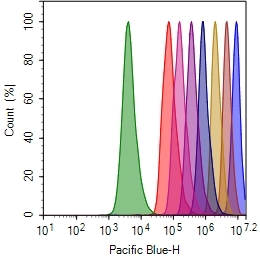CytoTell® Blue
Flow cytometry combined with fluorescence staining is a powerful tool to analyze heterogeneous cell populations. Among all the existing fluorescent dyes CFSE is the preferred cell proliferation indicator that is widely used for live cell analysis. However, it is impossible to use CFSE and its fluorescein analogs for GFP-transfected cells or for the applications where a FITC-labeled antibody is used since CFSE and its fluorescein analogs have the excitation and emission spectra almost identical to GFP or FITC. CytoTell® dyes are well excited at major laser lines such as 405 nm, 488 nm or 633 nm with multicolor emissions. CytoTell® dyes have minimal cytotoxicity, and are used for the multicolor applications with either GFP cell lines or FITC-labeled antibodies since they have either excitation or emission spectra distinct from fluorescein. CytoTell® Blue is a blue fluorescent dye that stains cells evenly. As cells divide, the dye is distributed equally between daughter cells that can be measured as successive halving of the fluorescence intensity of the dye. Cells labeled with CytoTell® Blue may be fixed and permeabilized for analysis of intracellular targets using standard formaldehyde-containing fixatives and saponin-based permeabilization buffers. CytoTell® Blue has a peak excitation of 405 nm and can be excited by the violet (405 nm) laser line. It has a peak emission of 450 nm and can be detected with a 450/20 band pass filter (equivalent to Pacific Blue®, or BD Horizon® V450), making it compatible with applications that utilize GFP or FITC antibodies for multicolor cell analysis.


| Catalog | Size | Price | Quantity |
|---|---|---|---|
| 22251 | 500 Tests | Price | |
| 22252 | 2x500 Tests | Price |
Physical properties
| Molecular weight | 379.71 |
| Solvent | DMSO |
Spectral properties
| Excitation (nm) | 410 |
| Emission (nm) | 445 |
Storage, safety and handling
| H-phrase | H303, H313, H333 |
| Hazard symbol | XN |
| Intended use | Research Use Only (RUO) |
| R-phrase | R20, R21, R22 |
| Storage | Freeze (< -15 °C); Minimize light exposure |
| UNSPSC | 12352200 |
Instrument settings
| Flow cytometer | |
| Excitation | 405 nm laser |
| Emission | 450/40 nm filter |
| Instrument specification(s) | Pacific Blue channel |
Documents
Contact us
| Telephone | |
| Fax | |
| sales@aatbio.com | |
| International | See distributors |
| Bulk request | Inquire |
| Custom size | Inquire |
| Technical Support | Contact us |
| Request quotation | Request |
| Purchase order | Send to sales@aatbio.com |
| Shipping | Standard overnight for United States, inquire for international |
Page updated on December 17, 2025

